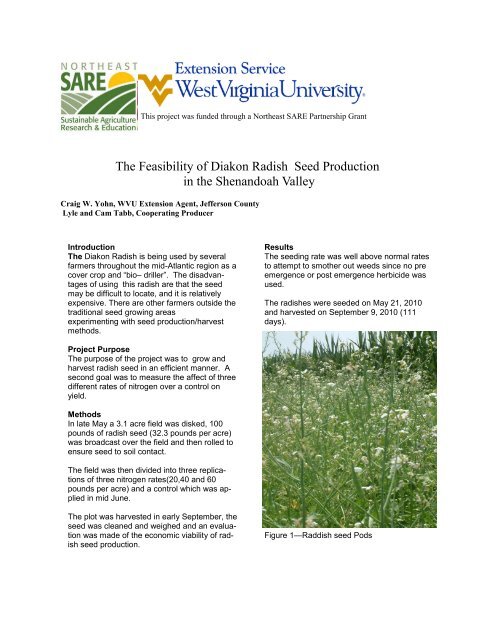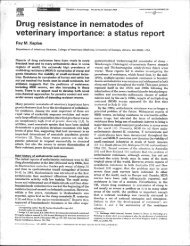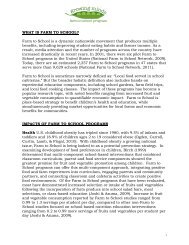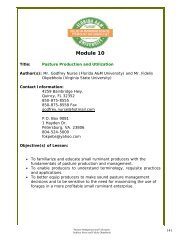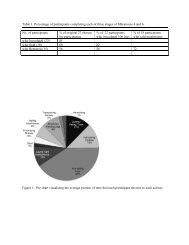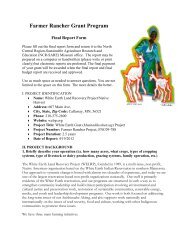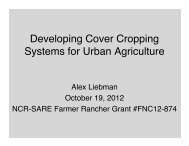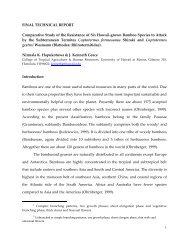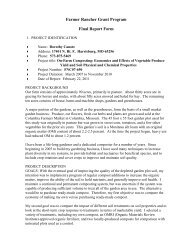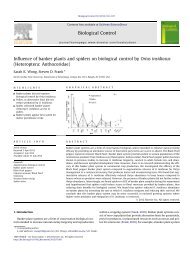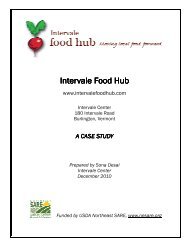The Feasibility of Diakon Radish Seed Production in the ...
The Feasibility of Diakon Radish Seed Production in the ...
The Feasibility of Diakon Radish Seed Production in the ...
You also want an ePaper? Increase the reach of your titles
YUMPU automatically turns print PDFs into web optimized ePapers that Google loves.
This project was funded through a Nor<strong>the</strong>ast SARE Partnership Grant<br />
<strong>The</strong> <strong>Feasibility</strong> <strong>of</strong> <strong>Diakon</strong> <strong>Radish</strong> <strong>Seed</strong> <strong>Production</strong><br />
<strong>in</strong> <strong>the</strong> Shenandoah Valley<br />
Craig W. Yohn, WVU Extension Agent, Jefferson County<br />
Lyle and Cam Tabb, Cooperat<strong>in</strong>g Producer<br />
Introduction<br />
<strong>The</strong> <strong>Diakon</strong> <strong>Radish</strong> is be<strong>in</strong>g used by several<br />
farmers throughout <strong>the</strong> mid-Atlantic region as a<br />
cover crop and ―bio– driller‖. <strong>The</strong> disadvantages<br />
<strong>of</strong> us<strong>in</strong>g this radish are that <strong>the</strong> seed<br />
may be difficult to locate, and it is relatively<br />
expensive. <strong>The</strong>re are o<strong>the</strong>r farmers outside <strong>the</strong><br />
traditional seed grow<strong>in</strong>g areas<br />
experiment<strong>in</strong>g with seed production/harvest<br />
methods.<br />
Project Purpose<br />
<strong>The</strong> purpose <strong>of</strong> <strong>the</strong> project was to grow and<br />
harvest radish seed <strong>in</strong> an efficient manner. A<br />
second goal was to measure <strong>the</strong> affect <strong>of</strong> three<br />
different rates <strong>of</strong> nitrogen over a control on<br />
yield.<br />
Methods<br />
In late May a 3.1 acre field was disked, 100<br />
pounds <strong>of</strong> radish seed (32.3 pounds per acre)<br />
was broadcast over <strong>the</strong> field and <strong>the</strong>n rolled to<br />
ensure seed to soil contact.<br />
<strong>The</strong> field was <strong>the</strong>n divided <strong>in</strong>to three replications<br />
<strong>of</strong> three nitrogen rates(20,40 and 60<br />
pounds per acre) and a control which was applied<br />
<strong>in</strong> mid June.<br />
<strong>The</strong> plot was harvested <strong>in</strong> early September, <strong>the</strong><br />
seed was cleaned and weighed and an evaluation<br />
was made <strong>of</strong> <strong>the</strong> economic viability <strong>of</strong> radish<br />
seed production.<br />
Results<br />
<strong>The</strong> seed<strong>in</strong>g rate was well above normal rates<br />
to attempt to smo<strong>the</strong>r out weeds s<strong>in</strong>ce no pre<br />
emergence or post emergence herbicide was<br />
used.<br />
<strong>The</strong> radishes were seeded on May 21, 2010<br />
and harvested on September 9, 2010 (111<br />
days).<br />
Figure 1—Raddish seed Pods
Figure 2 - <strong>Radish</strong> Field <strong>in</strong> Bloom<br />
Figure 3 - <strong>Radish</strong> Bloom<br />
Escape weeds were still an issue even with <strong>the</strong><br />
high seed<strong>in</strong>g rate and impacted <strong>the</strong> harvest<strong>in</strong>g<br />
process as can be seen <strong>in</strong> figures 4 - 7.<br />
Figure 4 - Comb<strong>in</strong>e enter<strong>in</strong>g <strong>the</strong> Field<br />
Figure 5 - Major weed problem was lambs<br />
quarter.<br />
Figure 6 - Green cast <strong>of</strong> field demonstrates<br />
weed issues.<br />
Figure 7 - Comb<strong>in</strong>e had difficulties with ‗green‖<br />
material
Figure 8 <strong>Radish</strong> <strong>Seed</strong> after First Clean<strong>in</strong>g<br />
<strong>The</strong> lambs quarter and o<strong>the</strong>r weeds comb<strong>in</strong>ed<br />
to <strong>in</strong>crease <strong>the</strong> amount <strong>of</strong> undesirable foreign<br />
matter <strong>in</strong> <strong>the</strong> seed. This made <strong>the</strong> evaluation<br />
<strong>of</strong> <strong>the</strong> nitrogen applications difficult to evaluate<br />
<strong>the</strong>ir impact on yield. Lyle Tabb and <strong>the</strong> Extension<br />
Agent agreed that evaluat<strong>in</strong>g <strong>the</strong> nitrogen<br />
rates was not practical and would not provide<br />
any useable data.<br />
Figure 9 - Unclean <strong>Radish</strong> <strong>Seed</strong><br />
<strong>The</strong> entire field was harvested and <strong>the</strong>n run<br />
through a seed cleaner twice. Which removed<br />
most <strong>of</strong> <strong>the</strong> foreign material.<br />
Figure 10 - V<strong>in</strong>tage 1930‘s <strong>Seed</strong> Cleaner last<br />
used to clean wheat for seed<br />
Figure 11 - Lyle Tabb Fill<strong>in</strong>g <strong>the</strong> <strong>Seed</strong><br />
Cleaner<br />
Figure 12 - Cleaned seed
Economics<br />
An evaluation <strong>of</strong> <strong>the</strong> economics <strong>of</strong> produc<strong>in</strong>g radish seed for farm use is summarized <strong>in</strong> Table 1.<br />
Table 1—Economic Summary <strong>of</strong> <strong>Radish</strong> Plant<strong>in</strong>g<br />
Acres Pounds lbs./acre<br />
3.1 245.0 79.0<br />
Cost per pound $0.50<br />
Nitrogen Cost $20.00<br />
Tillage $18.00<br />
Broadcast $11.00<br />
<strong>Seed</strong> (Pounds) 32.30<br />
<strong>Seed</strong> Cost $3.50<br />
<strong>Seed</strong> $113.05<br />
Harvest $30.00<br />
Clean<strong>in</strong>g $25.00<br />
Total Cost $217.05<br />
Income<br />
Pounds 79.0<br />
Price $3.00<br />
Gross Income $237.10<br />
Net $20.05<br />
Cost per Pound $2.75<br />
<strong>The</strong> budget above demonstrates that if an average <strong>of</strong> 40 pounds <strong>of</strong> nitrogen was applied to <strong>the</strong> field <strong>the</strong><br />
cost per pound <strong>of</strong> seed harvested and cleaned would be $2.75 per pound. <strong>Seed</strong> ranges <strong>in</strong> price from<br />
$3.00 - $4.50 per pound.<br />
Summary<br />
In this one year trial <strong>of</strong> evaluat<strong>in</strong>g grow<strong>in</strong>g <strong>Diakon</strong> <strong>Radish</strong> for seed, it is marg<strong>in</strong>al as a means <strong>of</strong> grow<strong>in</strong>g<br />
your own seed. Weed control is a major concern that must be addressed <strong>in</strong> <strong>the</strong> future. Lower seed<strong>in</strong>g<br />
rates may also be more appropriate if weeds can be controlled. This will also allow <strong>the</strong> comb<strong>in</strong>e to play<br />
a larger part as <strong>the</strong> seed cleaner.<br />
In this one year trial ra<strong>in</strong> fall was significantly lower than average ( a deficit <strong>of</strong> 6.01 <strong>in</strong>ches between May<br />
and August). This may have affected <strong>the</strong> out come <strong>of</strong> <strong>the</strong> trial as <strong>the</strong> full yield potential <strong>of</strong> <strong>the</strong> crop could<br />
not be expressed.<br />
O<strong>the</strong>r Observations<br />
<strong>Seed</strong><strong>in</strong>g could occur <strong>in</strong> <strong>the</strong> early spr<strong>in</strong>g (March) ra<strong>the</strong>r than wait<strong>in</strong>g until May as plants <strong>in</strong> o<strong>the</strong>r trials<br />
were observed flower<strong>in</strong>g <strong>in</strong> April.<br />
Acknowledgements<br />
<strong>The</strong> Extension Agent wishes to thank <strong>the</strong> cooperation and dedication <strong>of</strong> producer cooperators<br />
Lyle and Cam Tabb to this trial which took over a year to complete. This project was funded through a<br />
cooperative grant from Nor<strong>the</strong>ast SARE.


